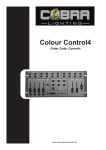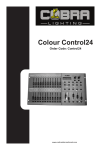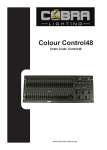Download Cobra Colour Control 12 User manual
Transcript
Colour Control6 Order Code: Control6 www.cobrainternational.com Dear Customer, User Manual Cobra Colour Control 6 Thank you for purchasing the Cobra Colour Control 6. With decades of experience in design and production, Cobra is one of the leading manufacturers of professional sound and lighting equipment. This unit has been designed and manufactured to the highest of standards so you can be assured you have made a good investment. For optimum safety and to take full advantage of all the Cobra Control 6 features, please ensure you read this manual in full. Product Description The Cobra Colour Control 6 is a 6 channel DMX controller, suitable for use with dimmer packs, LED lighting and effects lights. The controller is manual controller with six faders and one master dimmer fader. The Control 6 can be used with a battery, or be connected to the mains. Safety Advice 1. Read this manual in full before operating this product. 2. Keep this manual in a safe place for future reference. 3. Carry and transport this product with care. Dropping this product may result in serious mechanical failure. 4. The manufacturer accepts no responsibility for injury or damage caused by not following the manual provided. 2 Protection from Electric Shock 1. Do not connect the AC power plug to the unit before connecting your lights. 2. Only connect this unit to a mains socket with suitable trip and RCD protection. 3. To disconnect from the mains socket always remove by the mains plug. Do not attempt to remove by pulling the mains cable. 4. Disconnect the unit from the mains supply before cleaning. Cleaning should be carried out with a soft, dry cloth. 5. Do not expose this unit to any liquids. 6. Do not operate near exposed water or in high humidity. 7. Choose a suitable route for mains cables, ensuring trip hazards are avoided and the mains cable is not at risk of being crushed. 8. Do not open this unit to service. There are no user serviceable parts inside. Any servicing or repairs should be carried out by a qualified engineer only. Any user attempt to service or adapt this unit will void your warranty and could result in serious malfunction or injury. Protection from Fire 1. Do not place near sources of heat or ignition. 2. Do not block any ventilation holes. 3. Check your AC wall socket will take the power you are applying to avoid overloading the mains supply. 4. Ensure you are using the correct voltage DC power supply, set to the correct polarity. Protection from Injury and Damage 1. Do not attempt to modify this unit. 2. Always install the unit in a suitable location where vibrations to the unit are avoided. 3. Check this unit matches the mains voltage and frequency before plugging it in to your mains socket. 4. If any liquids or objects have entered the unit, switch it off immediately and consult a qualified engineer. 5. In the event of malfunction or damage to the mains cable, disconnect from the mains supply immediately and consult a qualified engineer. 6. All parts should be replaced with genuine spare parts and carried out by a qualified engineer. Contents & Unpacking 1. The box should contain Cobra Colour Control 6, DC power supply and user manual. 2. If you suspect any damage or missing parts, please contact your dealer immediately. Specifications Name: Colour Control 6 Code: Control 6 Power supply: DC 12v 100mA min. PP3 9v Battery Power consumption: 2 watts Output: DMX 512 (3-pin XLR) Dimensions: 173 x 153 x 55mm Weight: 0.8kg Features The Colour Control 6 is DMX 6-channel controller suitable for DMX products up to six channels. Features Include 1.Small, lightweight and portable. 2.6 manual channel faders. 3.1 master dimmer fader. 4.Battery or mains operated. 5.Polarity Switch. Troubleshooting If fixture is not responding to DMX 1.Check all connections are correct. 2.Check DMX addressing is correct. 3 Controller Front 1. 1-6 Channel faders. 2. Master dimmer fader. 3. Power LED Rear Panel 1. 3pin DMX out. 2. Polarity switch. 3. On/off power switch. 4. DC input. Connect a 12v 100mA min adaptor. 4 Common Terms The following are common terms used in intelligent light programming: 1. Blackout - is a state where by all lighting fixtures light output is set to '0' or 'off', usually on a temporary basis. 2. DMX-512 - is an industry standard digital communication protocol, frequently used in entertainment lighting equipment. 3. Fixture - refers to your lighting effect or other device such as a dimmer, which you can control. 4. Sliders - are also known as faders. 5. Scanner - refers to a lighting effect which has a pan and tilt mirror; However DMX controllers may refer to this term when describing the control of a DMX512 compatible device. 6. MIDI - is a standard term for representing musical information in a digital format. A MIDI input provides external triggering of scenes using MIDI devices such as a MIDI keyboard. 7. Stand Alone - refers to a fixtures ability to function independently of an external controller. This is usually in sync to music due to a built in microphone. 8. Fader slider - is used to adjust the fade time between scenes within a chase. 9. Speed slider - affects the amount of time a scene will hold its state. It is also considered a wait time. 10.Shutter - is a mechanical device in the lighting fixture that allows you to block the lights path. It is often used to lessen the intensity of the light output or strobe. 11.Playbacks - can either be scenes or chases that are directly recalled by the user. A playback may also be considered a program memory which can be used during a show. 12.Patching – refers to the process of assigning faders to a DMX channel fixture. First Time Operation 1. Remove all packaging materials. 2. Connect a DMX cable from controller to your first light or pack. Connect a DMX cable from the first light or pack to the second. Do this until all lights or packs are connected. 3. Plug any par can/theatre spots in to your dimmer packs if you are using dimmer packs. 4. Plug your controller into the mains with the supplied AC/DC power supply or with a PP3 battery (not provided). 5. Plug your dimmer packs or lights in to the mains. 6. Set correct DMX addresses on your lights or dimmers. Some lights or packs have dip-switches. Some have digital displays. 7. Once you have turned on your controller, move up the master slider. 8. You are now ready to use your controller. If you find the lights or dimmers are not functioning, try switching the polarity switch at the rear. Troubleshooting If fixture is not responding to DMX 1.Check all connections are correct. 2.Check DMX addressing is correct. 3.Check master dimmer fader is up. 4.Check polarity switch at the back of the unit is in the correct position. 5.Check fade slider is up to the top. 6.If all the above fails to work, unplug from the mains, wait 30 seconds then reconnect to the power supply. 7.If it is still not working, contact your dealer. 5 DMX BASICS DMX is short for digital multiplexer, which is a universal protocol designed for the lighting industry allowing for controlling of intelligent fixtures like scanners, moving heads, LED par cans, dimmer packs, fog machines etc. DMX allows you to control many fixtures channels, normally up to 512 with varying channels from 0255 (0-100%). This will give control of channels like gobo selection, up and down movements, colours and dimming etc. DMX is a very good system as all this information can be sent down one cable, used in conjunction with a DMX controller with memory all your channel settings can be saved and recalled easily. DMX was designed so that all manufacturers can use the same protocol/language to control their fixtures allowing the end user to use any make of fixture on their DMX controller as long as both are DMX compatible, and the controller has enough channels to control the fixture that is attached. Fixtures have an input and output DMX socket, allowing you to connect from the controller to the first fixture then from that fixture to the next (this is called daisy chaining). Sockets are normally 3 pin XLR but can be 5 pin XLR as well. DMX fixtures need to have a DMX address set, as this is so they can then decode the correct information from the controller. This is normally done by a digital display panel, where the address can be changed by simple up and down buttons; the address ranges from 1-512. In addition to this it can be controlled by a row of small switches, called dip switches; there the required address is converted to a binary number. To work out your dip switch settings you can simply download a DMX calculator from the internet or see our table further on. The order in which fixtures are connected in a DMX line does not influence the DMX address, a fixture set to DMX address 1 can be put in a DMX line from beginning, middle or end, as it is set to address 1 it knows to take information from that point onwards. 6 DMX Wiring: 3 pin wiring is more common, 5 pin is the correct way. 3 pin may be used to save on cost. With 5 pin connections, not all pins are used, though it is worth checking your manual for your fixture, as some lights use the unused pins for low voltage control. 5 pin would be better so there is no confusion over mixer leads and DMX leads in big rigs, sending a mixers 48v phantom power down a DMX cable could damage the DMX light. When making cables try and used proper DMX cable and do not connect pin 1 GND to the outer casing of the connector as you might do with audio cables as this may cause erratic behaviour from your fixture. Do not make Y leads to split cables to fixtures; always use the in and out sockets or a DMX splitter as again this may cause erratic behaviour from your fixture. We recommend you to put a DMX terminator in any fixture which hasn’t got a DMX lead connected from the output socket to another fixture; this again is to reduce erratic behaviour from your fixtures. A DMX terminator is simply a male XLR plug with 120 ohms, ¼ watt resistor soldered across pin 2 & 3. 7 Each fixture takes up 5 DMX Channels (See Above) The controller is a fairly basic 24 channel. So you have a cable from the controller to the first fixture cable from first to second and so on, the last light has a DMX terminator plugged in. Fixture 1 would be set to DMX address: 1 dipswitch number 1 on. Fixture 2 would be set to DMX address: 6 dipswitch numbers 2 & 3 on. Fixture 3 would be set to DMX address: 11 dipswitch numbers 1, 2 & 4 on. Fixture 4 would be set to DMX address: 16 dipswitch number 5 on. We would recommend you to fully read manuals for your light and controller as some controllers tell you what each fixture address needs to be, and some lights need other settings changed to make them work. 8 When setting address you need to make sure fixtures don’t overlap from one to the next. You can set 2 fixtures to the same address, and as long as they are the same fixture (i.e. same channel layout) they will then do the same as each other. 9 DMX DIPSWITCH SET 0=OFF 1 = ON X = OFF OR ON 1 2 3 4 5 0 0 0 0 0 1 0 0 0 0 0 1 0 0 0 1 1 0 0 0 0 0 1 0 0 1 0 1 0 0 0 1 1 0 0 1 1 1 0 0 0 0 0 1 0 1 0 0 1 0 0 1 0 1 0 1 1 0 1 0 0 0 1 1 0 1 0 1 1 0 0 1 1 1 0 1 1 1 1 0 0 0 0 0 1 1 0 0 0 1 0 1 0 0 1 1 1 0 0 1 0 0 1 0 1 1 0 1 0 1 0 1 1 0 1 1 1 1 0 1 0 0 0 1 1 1 0 0 1 1 0 1 0 1 1 1 1 0 1 1 0 0 1 1 1 1 0 1 1 1 0 1 1 1 1 1 1 1 1 1 9 8 7 6 0 0 1 0 64 65 66 67 68 69 70 71 72 73 74 75 76 77 78 79 80 81 82 83 84 85 86 87 88 89 90 91 92 93 94 95 0 0 0 1 32 33 34 35 36 37 38 39 40 41 42 43 44 45 46 47 48 49 50 51 52 53 54 55 56 57 58 59 60 61 62 63 0 0 0 0 1 2 3 4 5 6 7 8 9 10 11 12 13 14 15 16 17 18 19 20 21 22 23 24 25 26 27 28 29 30 31 96 97 98 99 100 101 102 103 104 105 106 107 108 109 110 111 112 113 114 115 116 117 118 119 120 121 122 123 124 125 126 127 0 0 1 1 128 129 130 131 132 133 134 135 136 137 138 139 140 141 142 143 144 145 146 147 148 149 150 151 152 153 154 155 156 157 158 159 0 1 0 0 160 161 162 163 164 165 166 167 168 169 170 171 172 173 174 175 176 177 178 179 180 181 182 183 184 185 186 187 188 189 190 191 0 1 0 1 192 193 194 195 196 197 198 199 200 201 202 203 204 205 206 207 208 209 210 211 212 213 214 215 216 217 218 219 220 221 222 223 0 1 1 0 224 225 226 227 228 229 230 231 232 233 234 235 236 237 238 239 240 241 242 243 244 245 246 247 248 249 250 251 252 253 254 255 0 1 1 1 256 257 258 259 260 261 262 263 264 265 266 267 268 269 270 271 272 273 274 275 276 277 278 279 280 281 282 283 284 285 286 287 1 0 0 0 288 289 290 291 292 293 294 295 296 297 298 299 300 301 302 303 304 305 306 307 308 309 310 311 312 313 314 315 316 317 318 319 1 0 0 1 TABLE SET DMX ADDRESS 320 321 322 323 324 325 326 327 328 329 330 331 332 333 334 335 336 337 338 339 340 341 342 343 344 345 346 347 348 349 350 351 1 0 1 0 352 353 354 355 356 357 358 359 360 361 362 363 364 365 366 367 368 369 370 371 372 373 374 375 376 377 378 379 380 381 382 383 1 0 1 1 384 385 386 387 388 389 390 391 392 393 394 395 396 397 398 399 400 401 402 403 404 405 406 407 408 409 410 411 412 413 414 415 1 1 0 0 416 417 418 419 420 421 422 423 424 425 426 427 428 429 430 431 432 433 434 435 436 437 438 439 440 441 442 443 444 445 446 447 1 1 0 1 448 449 450 451 452 453 454 455 456 457 458 459 460 461 462 463 464 465 466 467 468 469 470 471 472 473 474 475 476 477 478 479 1 1 1 0 480 481 482 483 484 485 486 487 488 489 490 491 492 493 494 495 496 497 498 499 500 501 502 503 504 505 506 507 508 509 510 511 1 1 1 1















